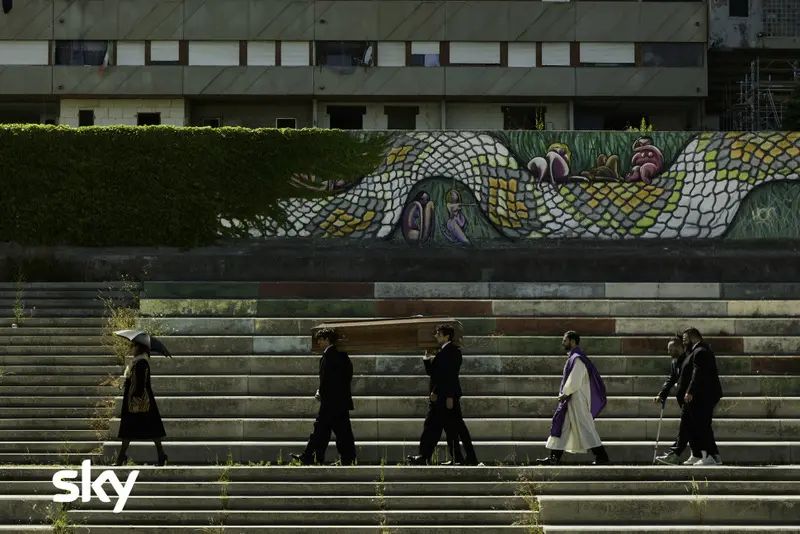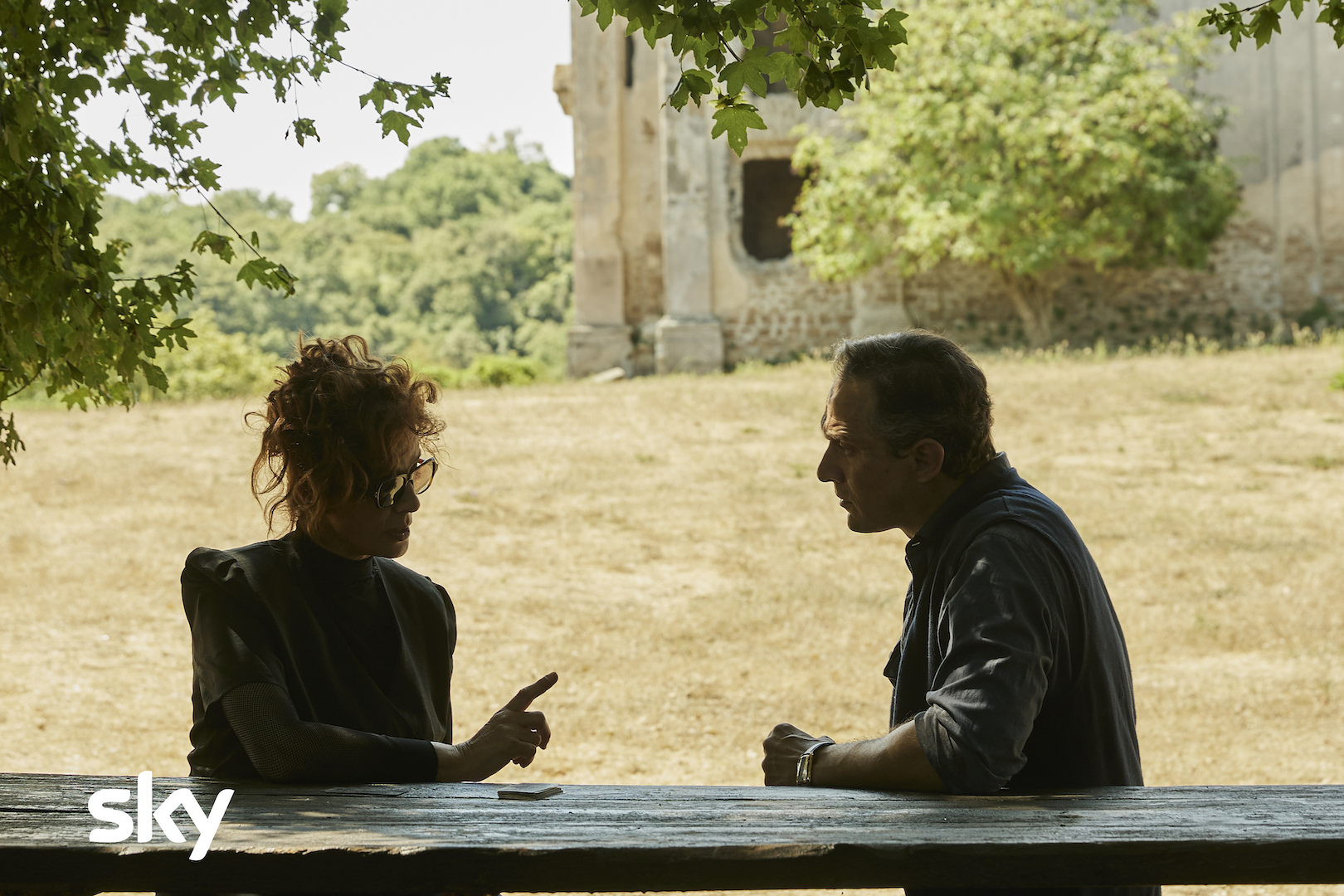

Christian, supernatural-crime series directed by Stefano Lodovichi, tells the story of the "holy fighter", played by Edoardo Pesce, a small-time suburban hoodlum who earns his living fighting - the only thing he knows how to do: when stigmata appear on his hands, he becomes a saint. The pulp-themed story is set against the backdrop of Città-Palazzo (lit. Building-City): a stratified, multi-ethnic, suspended place, that was created for the film by combining elements of different spaces on the Roman outskirts. A sort of giant hive that guards the desperate but also colourful life of its inhabitants.
“Like the Vele are a symbol for Gomorrah in the world, we wanted to create a precise iconography with the Città-Palazzo, with a strong identity,” underlines the director. “Città-Palazzo is more than a neighbourhood, it is a self-sufficient micro-city, a fusion of two working-class neighbourhoods”.
The main location in the series Christian and its symbol is the imposing concrete expanse of the Corviale“serpentone” or "snake", which was merged with images of the Vigne Nuove residential complex. Designed in the Seventies, the large “snake” symbolizes a building utopia but today stands in isolation on the edges of the city of Rome. The enormous building was intended to incorporate a series of services for citizens, as a different way of conceiving the suburbs. However, the project failed - the works were delayed and the spaces, in particular those reserved for services, were occupied illegally - making the Corviale a symbol of the degradation and dilapidation of the Roman suburbs. In addition to the imposing and menacing concrete of the Corviale, the series also features streets in the elegant Parioli district and the bright gardens of the Celio hill.

In Season 2 of the "miracle series" directed by Stefano Lodovichi, the "forced utopia" promised by Christian to his followers – the redemption of an entire neighbourhood by becoming a community where equality, sharing and respect for others reign – comes true but unleashes new problems. The imaginary Città-Palazzo, the suburban neighbourhood of Rome where Christian dispenses miracles, becomes the stage for an unusual, mystical coup d'état that leads to the creation of a new kingdom.
Città-Palazzo (the Corviale), is again the key setting and symbolic place for choral moments but the development of new storylines and the introduction of new characters takes the season beyond its narrow confines to explore new territories.
Inspiration is provided by the characters, such as newly-arrived Nera (Laura Morante) and Biondo (Giulio Beranek): the setting of Monterano antica, where the remains of a glorious past re-appropriated by nature bear witness to its inevitable victory over man, contrasts with the solemn, metaphysical architecture of EUR which expresses Biondo's Enlightenment rationality.
Meanwhile, some real places from Season 1 were rebuilt on a soundstage: Tomei's laboratory, Christian and Rachele's houses and the interior of the Rectory, with video projections on large backdrops added to underline the relationship between the internal and the external.
Christian, supernatural-crime series directed by Stefano Lodovichi, tells the story of the "holy fighter", played by Edoardo Pesce, a small-time suburban hoodlum who earns his living fighting - the only thing he knows how to do: when stigmata appear on his hands, he becomes a saint. The pulp-themed story is set against the backdrop of Città-Palazzo (lit. Building-City): a stratified, multi-ethnic, suspended place, that was created for the film by combining elements of different spaces on the Roman outskirts. A sort of giant hive that guards the desperate but also colourful life of its inhabitants.
“Like the Vele are a symbol for Gomorrah in the world, we wanted to create a precise iconography with the Città-Palazzo, with a strong identity,” underlines the director. “Città-Palazzo is more than a neighbourhood, it is a self-sufficient micro-city, a fusion of two working-class neighbourhoods”.
The main location in the series Christian and its symbol is the imposing concrete expanse of the Corviale“serpentone” or "snake", which was merged with images of the Vigne Nuove residential complex. Designed in the Seventies, the large “snake” symbolizes a building utopia but today stands in isolation on the edges of the city of Rome. The enormous building was intended to incorporate a series of services for citizens, as a different way of conceiving the suburbs. However, the project failed - the works were delayed and the spaces, in particular those reserved for services, were occupied illegally - making the Corviale a symbol of the degradation and dilapidation of the Roman suburbs. In addition to the imposing and menacing concrete of the Corviale, the series also features streets in the elegant Parioli district and the bright gardens of the Celio hill.

In Season 2 of the "miracle series" directed by Stefano Lodovichi, the "forced utopia" promised by Christian to his followers – the redemption of an entire neighbourhood by becoming a community where equality, sharing and respect for others reign – comes true but unleashes new problems. The imaginary Città-Palazzo, the suburban neighbourhood of Rome where Christian dispenses miracles, becomes the stage for an unusual, mystical coup d'état that leads to the creation of a new kingdom.
Città-Palazzo (the Corviale), is again the key setting and symbolic place for choral moments but the development of new storylines and the introduction of new characters takes the season beyond its narrow confines to explore new territories.
Inspiration is provided by the characters, such as newly-arrived Nera (Laura Morante) and Biondo (Giulio Beranek): the setting of Monterano antica, where the remains of a glorious past re-appropriated by nature bear witness to its inevitable victory over man, contrasts with the solemn, metaphysical architecture of EUR which expresses Biondo's Enlightenment rationality.
Meanwhile, some real places from Season 1 were rebuilt on a soundstage: Tomei's laboratory, Christian and Rachele's houses and the interior of the Rectory, with video projections on large backdrops added to underline the relationship between the internal and the external.
